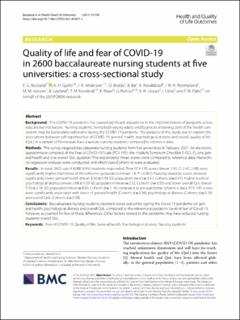| dc.description.abstract | Background
The COVID-19 pandemic has caused significant disruptions in the implementation of programs across educational institutions. Nursing students, being both young adults and by practical training, part of the health care system, may be particularly vulnerable during the COVID-19 pandemic. The purpose of this study was to explore the associations between self-reported fear of COVID-19, general health, psychological distress and overall quality of life (QoL) in a sample of Norwegian baccalaureate nursing students compared to reference data.
Methods
The survey targeted baccalaureate nursing students from five universities in February 2021. An electronic questionnaire consisted of the Fear of COVID-19 Scale (FCV-19S), the Hopkins Symptom Checklist 5 (SCL-5), one general health and one overall QoL question. The respondents’ mean scores were compared to reference data. Hierarchical regression analyses were conducted, and effect sizes (Cohen’s d) were evaluated.
Results
In total, 2605 out of 6088 (43%) students responded. Their FCV-19S scores (mean 2.45, CI 2.42, 2.48) were significantly higher than those of the reference population (mean 1.8, P < 0.001). Nursing students scores showed significantly lower general health (mean 3.50 ± 0.93 SD, population mean = 3.57, Cohen’s d = 0.07), higher levels of psychological distress (mean 2.68 ± 1.03 SD, population mean = 2.12, Cohen’s d = 0.55) and lower overall QoL (mean 5.50 ± 2.16 SD, population mean = 8.00, Cohen’s d = 1.16) compared to pre-pandemic reference data. FCV-19S scores were significantly associated with levels of general health (Cohen’s d = 0.26), psychological distress (Cohen’s d = 0.76) and overall QoL (Cohen’s d = 0.18).
Conclusions
Baccalaureate nursing students reported worse outcomes during the Covid-19 pandemic on general health, psychological distress and overall QoL compared to the reference population. Level of fear of Covid-19, however, accounted for few of these differences. Other factors related to the pandemic may have reduced nursing students’ overall QoL. | en_US |

